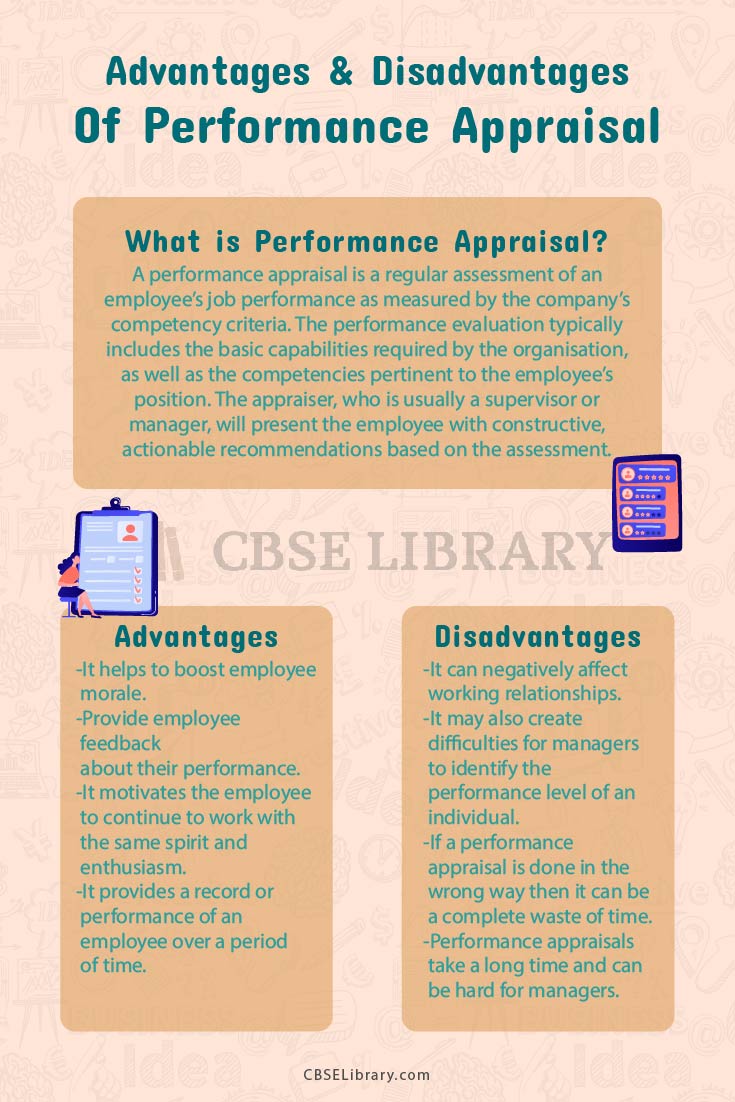Advantages And Disadvantages Of Performance Appraisal: Managers or direct supervisors evaluate an employee’s personality and performance against established criteria such as skillset, role knowledge, technical know-how, attitude, timeliness, and so on during a performance appraisal.
In different organisations, performance appraisal is referred to by various names: some call it performance evaluation, while others refer to it as a performance review, merit rating, or annual review.
This method is used to assess an employee’s intrinsic characteristics, as well as their abilities and level of competency, in order to assist them and the company they work for in growing and developing. Its purpose is to figure out how much an employee is worth and what he or she can offer the organisation.
Students can also find more Advantages and Disadvantages articles on events, persons, sports, technology, and many more.
Managers and supervisors can use performance appraisal to choose the best person for the position based on their skills. Every organisation, without a doubt, requires an effective performance appraisal system.
What is Performance Appraisal? Advantages and Disadvantages of Performance Appraisal
A performance appraisal is a regular assessment of an employee’s job performance as measured by the company’s competency criteria.
The performance evaluation typically includes the basic capabilities required by the organisation, as well as the competencies pertinent to the employee’s position.
The appraiser, who is usually a supervisor or manager, will present the employee with constructive, actionable recommendations based on the assessment. As a result, the individual receives the direction they require to advance and develop in their position.
Depending on the type of feedback provided, a performance appraisal can also be an opportunity for the company to recognise employee achievements and future potential.
Performance appraisals serve two purposes: they enable the organization to understand how employees contribute to the company and they help the employees develop in their roles.
A performance appraisal has two purposes: it assists the organisation in determining the value and productivity that employees offer, and it also assists employees in their own role development.
- Advantages of Performance Appraisal
- Disadvantages of Performance Appraisal
- Comparison Table for Advantages And Disadvantages Of Performance Appraisal
- FAQ’s on Advantages And Disadvantages Of Performance Appraisal
Objectives of Performance Appraisal
With the following objective in mind, a performance appraisal can be completed:
- In order to work out compensation packages, wage structures, and salary raises, among other things, keep records.
- Identifying employees’ strengths and weaknesses in order to place the best people in the best jobs.
- To keep track of and assess a person’s future potential for growth and development.
- Employees should be given feedback on their performance and status.
- Employees should be given feedback on their performance and status.
- It serves as a foundation for influencing the working habits of employees.
- Promotional and other training programmes will be evaluated and kept.
Type of Performance Appraisals
Some types of performance appraisals include:
- Traditional performance appraisals: An evaluation based on an employee’s work is conducted by a superior, and evidence is used to determine how well they are performing.
- 360-degree review: Superiors, colleagues, supervisors, and the individual evaluate each other, allowing for feedback from all directions of the team.
- Self-appraisals: Employees review their own performance, taking into account both their accomplishments and mistakes.
- Upward appraisal: Employees provide feedback on how their team leaders are doing.
- Negotiated appraisal: A mediator assists a manager and employee in discussing work performance, typically beginning with a review of the employee’s positive performance before offering constructive criticism.
- Employee-initiated review: An employee requests a review from their manager in order to determine how they are performing and to request more projects or a higher position.
- Group performance appraisal: The superiors of an organization evaluate the team’s performance, but sometimes employees are also invited to critique their colleagues.
Advantages of Performance Appraisal
- Creates career growth: Performance appraisals help employees grow in their careers, especially if they want to eventually advance with the company to a higher role. A regular evaluation can assist employees in developing a professional development plan.
- Improves performance: Giving feedback encourages employees to do well. Employees are motivated to work harder when their manager provides positive feedback. Because performance appraisals are frequently used to determine how to award bonuses, they can assist in providing employees with an incentive and reward for their efforts.
- Employee development: Appraisal systems determine which employees require additional training and serve as the primary source of information about the employees’ strengths and potential.
- Feedback: The feedback process enables managers to provide employees with feedback about their performance as well as to discuss how well the employee goals were achieved. It also allows the manager to discuss potential staff development opportunities.
Disadvantages of Performance Appraisal
- Error in contrast: Performance standards are used to determine all ratings. A contrast error occurs when an employee is assessed without taking into account the performance criterion. This might happen when a rater compares an employee’s current performance to their previous performance.
- Negative Experience: Performance appraisals can be a negative experience for both employees and managers if they are done incorrectly. This can be avoided by training on both the process and skills necessary.
- Time Consuming: Performance appraisals take a long time and can be overwhelming for managers who have a large number of employees. For example, if you’ve worked with managers who were in charge of performing annual performance appraisals on hundreds of employees then you may know.
- Waste of Time: If the entire process isn’t done correctly, the entire process can be a total waste of time. Consider how much time is spent if the outcome is negative. It can end up being a complete waste of time from start to finish.

Comparison Table for Advantages And Disadvantages Of Performance Appraisal
| Advantages | Disadvantages |
| It helps to boost employee morale. | It can negatively affect working relationships. |
| Provide employee feedback about their performance. | It may also create difficulties for managers to identify the performance level of an individual. |
| It motivates the employee to continue to work with the same spirit and enthusiasm. | If a performance appraisal is done in the wrong way then it can be a complete waste of time. |
| It provides a record or performance of an employee over a period of time. | Performance appraisals take a long time and can be hard for managers who have a large number of employees. |
FAQ’s on Advantages And Disadvantages Of Performance Appraisal
Question 1.
What is the Benefit of performance appraisal?
Answer:
Regularly completing performance appraisals can help companies keep their employees engaged and motivated to work harder.
Question 2.
What is the main purpose of a performance appraisal?
Answer:
The purpose of a performance appraisal is two-fold: It helps the organization to determine the value and productivity that employees contribute, and it also helps employees to develop in their own roles.
Question 3.
What are the four key elements of a good performance appraisal?
Answer:
The four elements of Purpose, Outcomes, Accountability and Teamwork need to be used as the foundation of a performance culture.
Question 4.
Goals of Performance Appraisal?
Answer:
In order to determine compensation packages, wage structures, salary raises, etc. This department maintains records in order to identify strengths and weaknesses so the right man can be placed in the right position and to evaluate and assess the potential present in an employee in order to maximize their ability to grow and develop.
